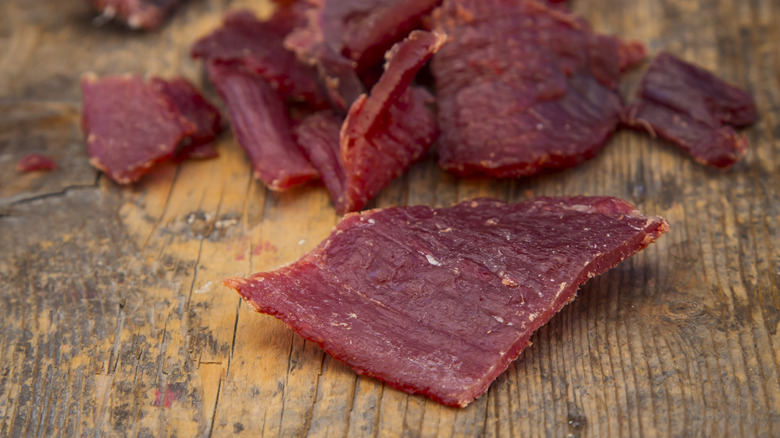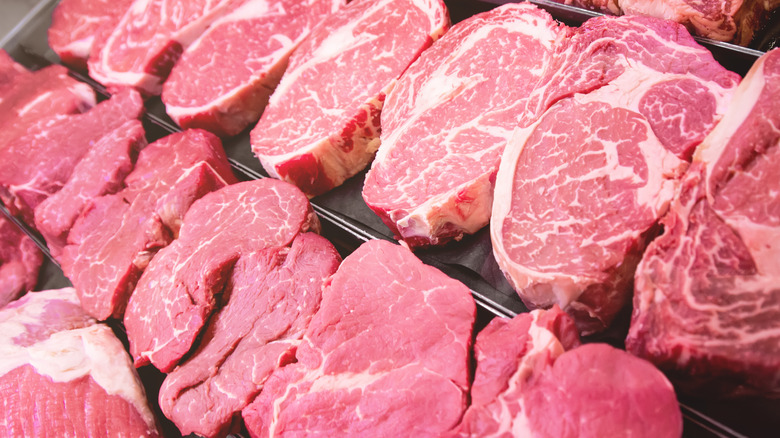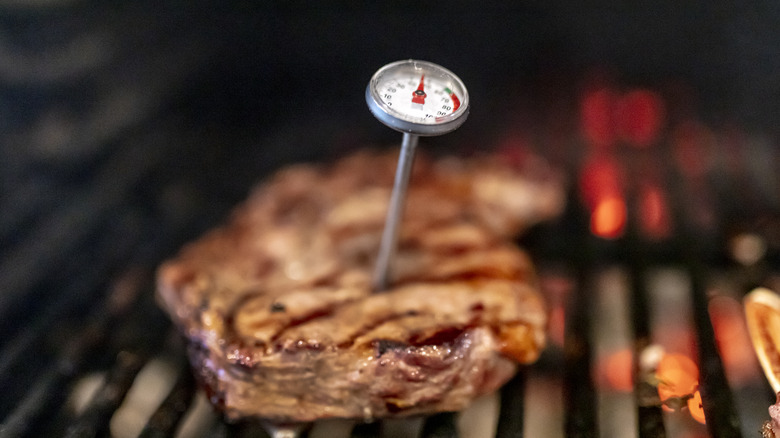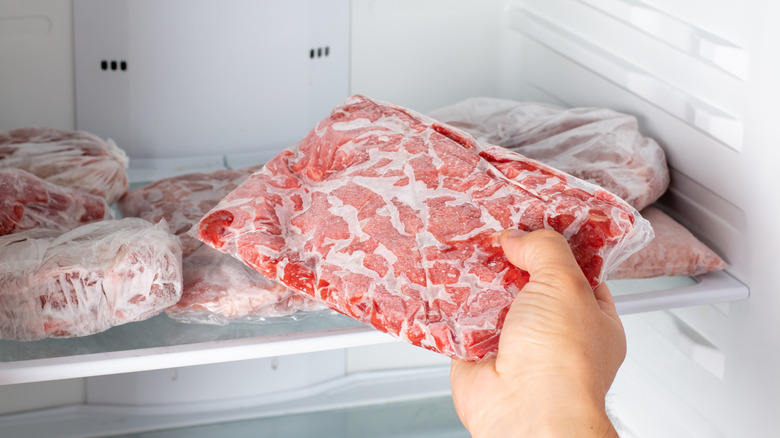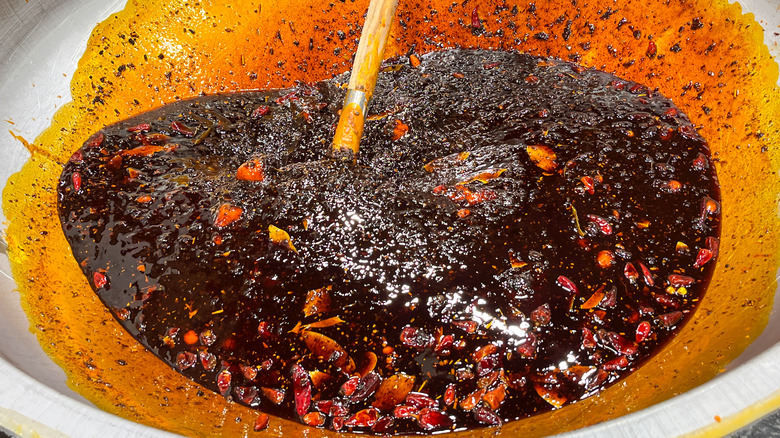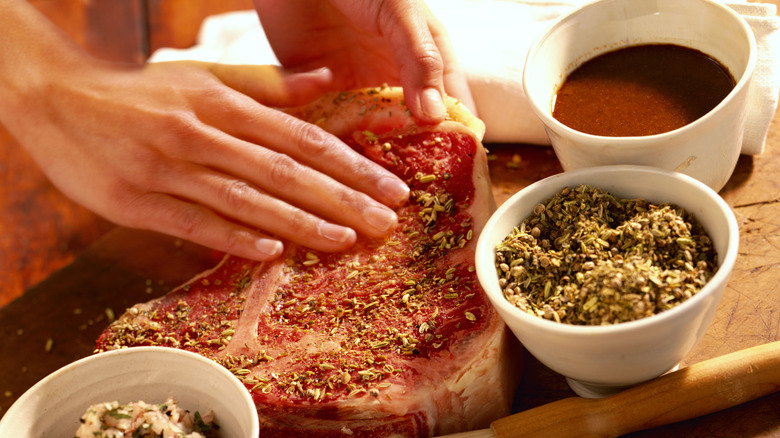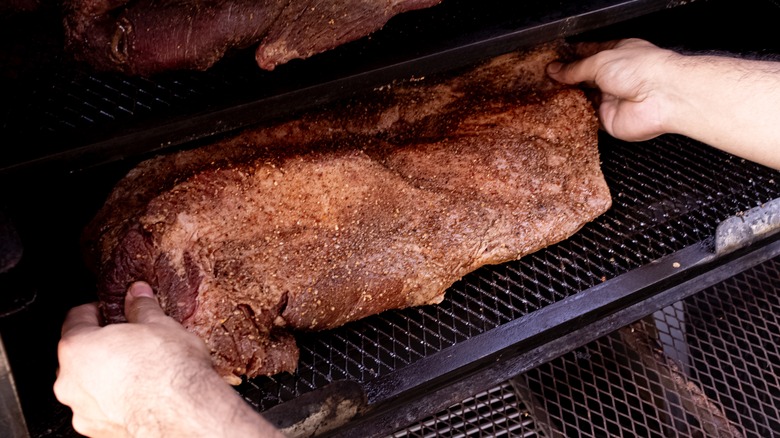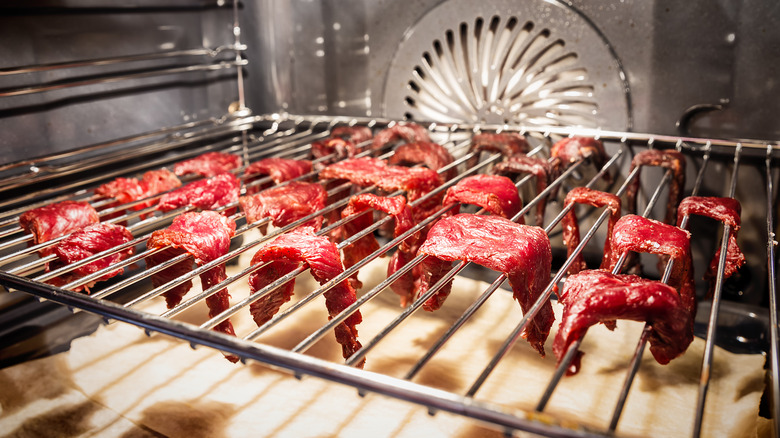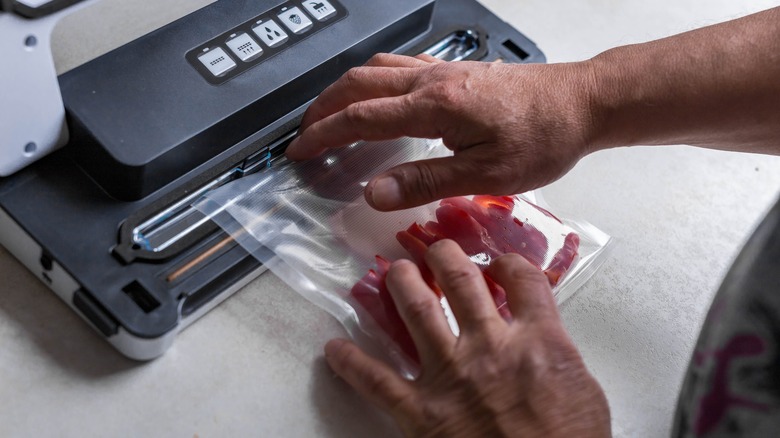11 Mistakes You Might Be Making With Homemade Beef Jerky, According To The Pros
As delicious as it is unpretentious, beef jerky has roots dating back to the Native Americans, who dried meat as a preservation method. This humble snack is known as an ideal source of on-the-go protein, and is popular with hikers, athletes, road trippers, and those following paleo and keto diets. The portable meat packs a significant protein punch, and is also a good source of essential iron and immune-boosting zinc. While it's easily accessible at almost any gas station or convenience store across the country, there are several benefits to making tasty beef jerky at home. If you've purchased the dried beef recently, you know that it isn't cheap. Beef jerky is expensive for several reasons, but the good news is that making your own is significantly more cost-effective. Also, prepackaged beef jerky tends to be high in salt, making it an unhealthy snacking option for those on a low-sodium diet. Making jerky yourself allows you to tailor it to your specific needs.
Although beef jerky is a simple snack made with just a few ingredients, making it from scratch is anything but simple. Creating taste-tempting dried beef strips is a science, and anything from using the wrong cut of meat to not slicing it properly can result in less-than-favorable results. I spoke to beef jerky experts Jess Pryles, founder of Hardcore Carnivore, and Will Wagner, founder of jerkyholic.com, to learn which beginner's mistakes to avoid so that you'll be a happy camper on your next outdoor adventure, or anywhere you want to enjoy your homemade dried beef.
Not selecting the right cut of beef
When choosing the best cut of meat for beef jerky from your local grocer or meat market, think outside of the display case. While you'd typically look for a steak featuring a lot of fat for the fullest flavor, the opposite is true when it comes to beef jerky. According to Will Wagner, lean meat with little fat is the best option when it comes to making beef jerky. He says that expensive beef, such as Wagyu, has too much marbling, and recommends going for cuts such as beef eye of round, bottom round, and top round, instead. Although it's a bit more expensive, sirloin tip is more tender than the other cuts listed.
Jess Pryles agrees and says that Wagyu might actually be less suited for making jerky because you want super lean meat if possible. She also adds that fat increases the chances of the jerky going rancid, so making dried beef is an excellent opportunity to use cheaper meat, even select grade. While using cheaper cuts of beef gives you more bang for your buck, make sure that you never purchase expired meat, even though you'll be drying it. When deciding on what kind of beef you should use for jerky, consider that a cut featuring a higher fat ratio will result in the jerky expiring faster.
Not taking food safety precautions
Packing improperly handled beef jerky in your picnic basket or backpack may result in a less-than-pleasant outdoor experience. Although beef jerky is a convenient snack because it doesn't require refrigeration, you still need to use basic food safety precautions when preparing it. No matter if you opt to dry your beef in a dehydrator, smoker, or oven, the meat must maintain an internal temperature 140 to 155 F for at least six hours to kill off harmful pathogens. Any less than that is risky and will put you at risk for food-borne illnesses such as salmonella and listeria.
The University of Wisconsin's Health & Well-Being Institute takes it a step further and recommends heating the dried beef jerky for an extra 10 minutes in a preheated oven set at 275 F for an extra margin of food safety. Jess Pryles agrees with this process, stating, "The meat must be brought to a minimum temp for a minimum amount of time — similar to the concept of pasteurization. Undercooking the meat can lead to food-borne illness, so to be sure that your jerky is safe, I like to finish it in a 275 F oven for eight to 10 minutes to ensure it's reached a safe temperature — these are USDA recommendations, too."
Will Wagner adds, "Not heating the meat to 160 F is the top reason people get sick from jerky. Properly clean your equipment and knives. Don't thaw meat at room temperature if frozen. Don't reuse leftover marinade."
Improperly planning your meat slicing
No matter how you slice it, the one mistake that will result in super-tough jerky that's unpleasant to chew is an improper cutting technique. Slicing the beef correctly will result in the proper texture, and will ensure that all meat strips dry uniformly. If the pieces of different thicknesses are used, some will be too chewy while others won't be cooked all the way through. The ideal meat thickness falls between ⅛ and ¼ inches, depending on your preference. Will Wagner shares that all beef strips should be the same size so they dry at the same rate. Also, don't slice meat against the grain, which will make it extremely tough to eat. He recommends using a sharp knife if you don't have a meat slicer, and to trim all excess fat from your raw beef during the slicing process.
While a knife may be the only option a beef jerky novice has to work with, Jess Pryles suggests using a meat slicer for best results. "One tool I think is essential for great quality jerky is a meat slicer," she says. "It's a little indulgent, but if you make jerky often it can be worth it. That will allow you to get the super thin pieces, which also jerky-fy faster!"
Forgetting to freeze the beef before slicing
Another essential step in beef jerky-making that you may forget to do is placing the meat in the freezer prior to slicing it. When the raw meat is chilled, any fat that it contains hardens, making the cut firmer and easier to slice. If the meat isn't put in the freezer before the slicing process, the room temperature beef may be too soft and jiggly, resulting in uneven strips. Cover the beef with plastic wrap before putting it into the freezer, and let it chill in there until it is almost frozen, but not rock hard. Keeping the beef in the freezer for about an hour typically results in the optimal firmness.
Set a timer to check the meat in the freezer after approximately 30 minutes, and inspect it again in 15 minutes if it isn't the desired firmness. In the meantime, make the most of the beef's chill time by preparing the mouthwatering meat marinade.
Not marinating the beef first
Marinating your beef before drying it into jerky serves several purposes. Creating a meat marinade allows you to completely customize the jerky flavor, giving it a signature taste. If you don't give the beef a flavorful bath before drying it, the jerky can end up tasting like leather. Prevent bland beef by making a mixture of liquid, herbs, and spices that will permeate the meat fibers, ensuring that every chew bite of jerky is a treat for your tastebuds. Give the meat enough time, typically up to 24 hours, to soak up the marinade in a covered, non-reactive bowl in your refrigerator.
Think of the technical aspects of beef jerky-making as a science, but creating a marinade as an art. Get creative by combining your favorite ingredients, such as Worcestershire or teriyaki sauce, liquid smoke flavoring, garlic and onion powder, along with the seasonings of your choice. If you need to use up some alcohol that's hiding in the back of your liquor cabinet, add some boozy ingredients to your marinades. And adding brown sugar to the marinade will not only add a sweetness that blends beautifully with the smoky and salty ingredients, but it will also help lock in moisture. If you're short on time or lack creative inspiration, a store-bought meat marinade will do in a pinch.
Marinating the beef for too long
As we all know, there can be too much of a good thing, even a mouthwatering marinade. When it comes to the perfect marinating time, you've got to know when enough is enough so that you don't over-soak the beef. The ideal amount of time to marinate beef for jerky is 16 hours, but anywhere between eight and 24 hours is acceptable. During this time frame, the marinade will saturate the meat, delivering salt and flavor all throughout the fibers. Also, thinner pieces of beef will require less soaking time than their thicker counterparts.
Although the various salts and acids, such as vinegar and citrus juices, in marinades are ideal for breaking down and tenderizing tough meat fibers, they can also turn them into mush after approximately 24 hours. Not only will over-marinading result in an icky texture, but it can also allow harmful bacteria to grow within the meat. It's also important to throw any extra marinade away rather than reusing it, to prevent the spread of bacteria that may be growing in the liquid.
Seasoning the beef too much or too little
Another secret to making delicious homemade beef jerky is the perfect combination and amount of seasonings. If you season the meat too much or too little, you may end up with blah-tasting dried beef. Just like with the marinating process, balance and precision is key when applying seasonings. After soaking the beef in the marinade, remove any excess liquid by patting it dry with paper towels, and then apply the dry seasonings to the meat. Again, get inventive with one-of-a-kind blends to give your beef jerky a customized flavor. Stick with basic seasonings such as garlic and onion powders, which will complement almost any marinade. To give your beef jerky a spicy kick, massage the raw meat with cayenne or chili powder. Smoked paprika will lend rich color as well as a deep, smoky note. Get creative with coriander or ginger, or give the jerky an Italian-inspired flavor with basil and oregano. You can also awaken your meat with Greek seasoning as another idea.
Start with just a little seasoning and add more according to your preferences. You can always add more to taste, but it's harder to remove excess seasoning from raw meat. Also, be careful not to over-salt the meat, or add too much pepper unless you want your jerky to be super spicy. You can also purchase specially designed beef jerky seasoning kits, featuring flavor themes such as Cajun, bourbon barbecue, sweet and spicy, and lime and jalapeño. If you're watching your sodium intake, opt for salt-free seasoning options.
Not having the right equipment to dry beef
Failing to use the proper equipment to dry your meat will end up costing you yummy beef jerky. If you plan on making beef jerky often, consider investing in a dehydrator. Look for one that features multiple stainless steel drying racks, customizable time and temperature settings, and enough space for making as much beef jerky as you'd like. Don't overlap the beef strips when you place them on the racks to ensure even, uniform drying. Will Wagner shares that you can also use a smoker to make beef jerky if you don't have a dehydrator. He also says that if you're just getting started, you can make jerky in an oven, but to stay away from any drying technique that doesn't heat the jerky to 160 F.
Jess Pryles uses a LEM brand dehydrator in her kitchen and agrees that a purpose-built dehydrator is the optimal machine for making beef jerky. She says that you can use your oven, but dehydrators operate at much lower temps, and allow you to set a timer as well. She recommends choosing a dehydrator that has precise temperature control, not just an on/off button. Here are the best food dehydrators under $100, according to reviews.
If you opt to go the smoker route, prep your machine with an aluminum foil-covered drip pan to prevent a mess later. Hang the strips of beef with toothpicks on a rack in the smoker's highest slots. Open the smoker's top vent, and dry the beef for one and a half hours at 170 F. Add water-soaked wood chips, and dry the beef between 180 F and 200 F for an hour before lowering the temperature to 160 F.
Using the wrong temperature and time in the oven
If you're new to the jerky-making scene and don't own a dehydrator or smoker yet, cooking the beef low and slow in the oven is an acceptable option. After properly slicing, marinating, and seasoning the beef, lay the strips across a baking sheet in a single layer. If you prefer to drape the strips directly over the racks, be sure to place a drip pan on the bottom of the oven first. Hang the strips on the racks using toothpicks, and spread them out evenly without overlapping. Preheat the oven to 175 F, and bake the beef between three to four hours, or until the internal temperature reaches 165 F. If you prefer a chewier texture, you can dry the beef a bit longer.
If you have two baking sheets of jerky, rotate them between the top and bottom racks midway through the baking process, at about the two-hour point. Remove the beef jerky from the oven and allow it to cool to room temperature before storing it.
Storing the homemade jerky improperly
After all of the hard work you've put into making perfectly seasoned and dried beef jerky, the last thing that you want to do is store it improperly. The dehydration process removes all moisture from the meat, allowing it to be stored outside of the refrigerator. For the longest shelf life, place the cooled beef jerky paper bags for a few days to make sure no moisture remains in the meat. Then, place the jerky in airtight plastic containers and store in a cool, dry place away from sunlight. You can also use zipper-sealed plastic bags to store the dried meat. Be sure to label the containers or bags with the storage date for safety and freshness.
Will Wagner says that freezer-packing the beef jerky is best, but you can store it in the refrigerator for a longer shelf life. "I like to keep the little silica-gel freshness packets that come in other products, and use them in the bags where I store my jerky — any way to lessen the moisture will make it last longer," adds Jess Pryles. "Also, vacuum sealing is really helpful for extending shelf life."
Skipping vacuum-sealed packaging or the freezer for long-term storage
If you've made more beef jerky than you can eat in the next few weeks, vacuum-sealing and then freezing the excess meat is the way to go. Taking these extra storage steps will ensure that the jerky will be fresh and safe to eat, or even give away as gifts during the holiday season. Here are the best ways to use your vacuum sealer if you're new to the process. Vacuum-sealing the jerky will remove all of the air from the packaging, creating a tight seal around the meat and slowing down the degradation process. If the packages are properly vacuum-sealed, your homemade beef jerky will remain fresh for approximately six months on a shelf in your pantry, and up to a year in a freezer.
Be sure to invest in a high-quality vacuum sealer that will remove all oxygen from packages, and prevent the exchange of moisture and air between the the jerky and it's surroundings. Not only will proper vacuum-sealing make the dried beef last longer, but it will also preserve the taste and aroma of it, too.
